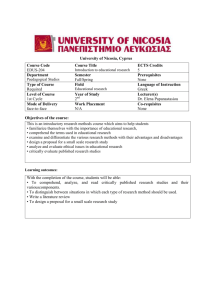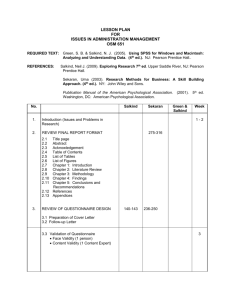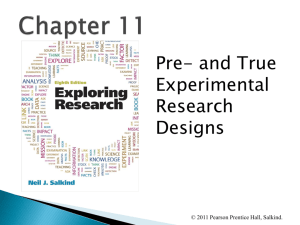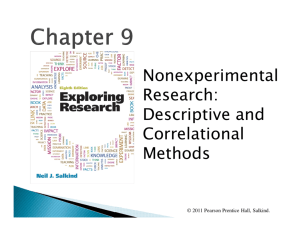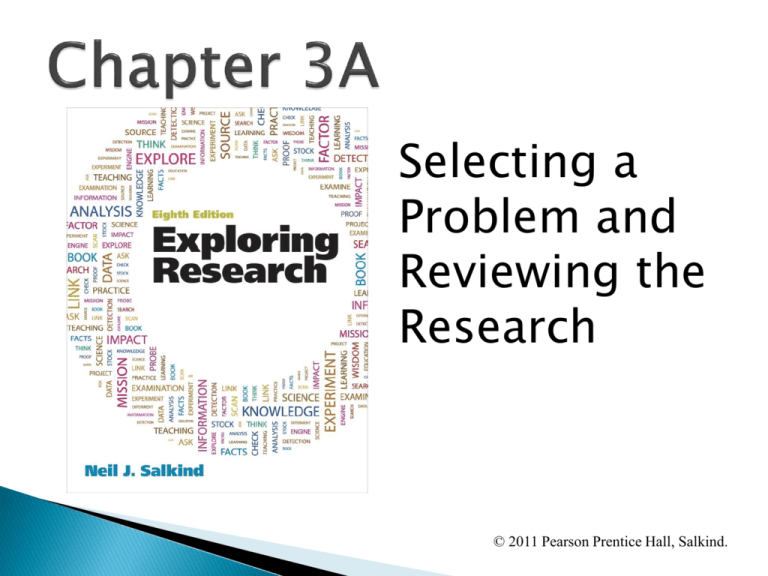
Selecting a
Problem and
Reviewing the
Research
© 2011 Pearson Prentice Hall, Salkind.
Discuss how to find a topic for a research
process.
Discuss how to develop an idea into a research
question, then a hypothesis.
Develop a research hypothesis.
Define the three types of sources for a literature
review.
Discuss how to use general, primary, and
secondary sources.
© 2011 Pearson Prentice Hall, Salkind.
Define terms related to a literature review.
Summarize how to use sources such as reviews,
indices, and journals to conduct a literature
review.
Describe how scholarly journals work.
Define electronic tools available via the WWW.
Discuss how to use a bibliographic database
program.
Demonstrate how to write a literature review.
© 2011 Pearson Prentice Hall, Salkind.
Selecting a Problem
Reviewing the Literature
Writing the Literature Review
© 2011 Pearson Prentice Hall, Salkind.
© 2011 Pearson Prentice Hall, Salkind.
Idea→Research Question →Research Hypothesis →Literature Review
From idea to literature review,
with the research hypothesis on the way.
Idea
Research Question
Literature Review
Research Hypothesis
From idea and literature review to hypothesis.
© 2011 Pearson Prentice Hall, Salkind.
Don’t fall in love with your idea
You may need to change your first idea
Don’t pick a trivial project
Don’t try to do more than is possible
Try to do something (somewhat) new
© 2011 Pearson Prentice Hall, Salkind.
Personal experiences or first-hand
knowledge
Ask your professors
Think about what has not yet been asked
Last resorts?
◦ Perhaps you can think of a question related to one of
the topics listed in the text
© 2011 Pearson Prentice Hall, Salkind.
You’ve identified an area of interest
Now formulate a research question that:
◦ Is a clearly stated expression of interest and intent,
and
◦ That implies a relationship between variables
© 2011 Pearson Prentice Hall, Salkind.
Stated in declarative form
Posits a relationship between variables
Reflects theory or literature
Brief and to the point
Testable
© 2011 Pearson Prentice Hall, Salkind.
For Example:
Research Interest
or Ideas
Research Problem or
Questions
Research Hypothesis
Open Classroom
and Academic
Success
What is the effect of open
versus traditional classrooms
on reading level?
Children who are taught reading in open classroom
settings will read at a higher grade level than children
who are taught reading in a traditional setting.
Television and
Consumer
Behavior
How does watching television
commercials affect the buying
behavior of adolescents?
Adolescent boys buy more of the products advertised on
television than do adolescent girls.
Effectiveness of
Checklists in
Preventing Hospital
Infections
Does the use of checklists
when preparing patients for
surgery help reduce the level of
infection in the hospital?
Those hospitals that regularly use checklists in patient
preparation for surgery will have a lower rate of infection
per 1,000 patients than these hospitals, which do not.
Do consumers prefer food that
is organic?
There will be a difference in preference level as
measured by the I Food scale between those consumers
who are offered organic food and those who are offered
non-organic food.
Use of Energy by
Home Owners
Will a home owner’s energy
usage change as a function of
his or her knowledge of his or
her neighbor’s usage?
Those people who know how much energy their
neighbors use on a monthly basis will use less energy.
Adult Care
How have many adults adjusted
to the responsibility of caring for
their aged parents?
The number of children who are caring for their parents
in the child’s own home has increased over the past 10
years.
Food Preference
and Organic Foods
© 2011 Pearson Prentice Hall, Salkind.
© 2011 Pearson Prentice Hall, Salkind.
Define your idea in as general terms as possible by using general sources.
Search through the secondary sources.
Search through the primary sources.
Organize your notes.
Write your proposal.
© 2011 Pearson Prentice Hall, Salkind.
Information
Source
What it Does
Example
General Sources
Provides an overview of a
topic and provides leads to
where more information
can be found.
Daily newspapers, news weeklies,
popular periodicals and magazines,
trade books, Reader’s Digest Guide to
Periodical Literature, New York Times
Index
Secondary
Sources
Provides a level of
information “once removed”
from the original work.
Books on specific subjects and reviews
of research
Primary Sources
The original reports of
the original work or
experience.
Journals, abstracts and scholarly books,
Educational Resources Information
Center (ERIC), movies
© 2011 Pearson Prentice Hall, Salkind.
General sources provide:
◦ A general introduction to topic areas
◦ Some clues to help search for more information
© 2011 Pearson Prentice Hall, Salkind.
The Reader’s Guide, Full Text Mega Edition
Facts on File Online Databases
The New York Times Index
Time
Newsweek
U.S. News and World Report
Lexis/Nexis Academic
Expanded Academic ASAP
Google Scholar and Google Books
Listing of Newspapers
Government Printing Office
The Statistical Abstract of the United States
© 2011 Pearson Prentice Hall, Salkind.
Currently, the Internet is unregulated (unlike
Secondary and Primary sources)
The Internet is good for fun and ideas:
◦ But be cautious!!
© 2011 Pearson Prentice Hall, Salkind.
Secondary sources provide:
◦ Scholarly summaries of research
◦ More sources of references
© 2011 Pearson Prentice Hall, Salkind.
Annual Reviews
The National Society for the Study of
Education
The Condition of Education
The Encyclopedia of Educational Research
Handbook of Child Psychology
Encyclopedia of Psychology
© 2011 Pearson Prentice Hall, Salkind.
Primary sources provide reports of original
research
Ulrich’s Periodicals Directory lists thousands
of periodicals, including journals
© 2011 Pearson Prentice Hall, Salkind.
Articles are written in a specific, uniform
format
Peer review:
◦ Experts review the article and make
recommendations
◦ Many submitted articles never get published
© 2011 Pearson Prentice Hall, Salkind.
An abstract is a one- or two-paragraph
summary of a journal article
You can use abstracts to help decide whether
a particular article will be useful
© 2011 Pearson Prentice Hall, Salkind.
PsychAbstracts and PsychInfo
◦ Subject area search
◦ Keyword search
Other abstracting sources
◦ Current Index to Journals in Education
◦ Educational Resources Information Center (ERIC)
◦ Child Development Abstracts & Bibliography
© 2011 Pearson Prentice Hall, Salkind.
What abstracts are available?
◦ Comprehensive Dissertation Index
Who’s done research in an area?
◦ Social Sciences Citation Index (SSCI)
◦ Science Citation Index (now part of the Web of
Science)
◦ Bibliographic Index
© 2011 Pearson Prentice Hall, Salkind.
Is the review of previous research complete and recent?
Are the problem and purpose clearly stated?
Are the research hypotheses clearly stated?
Is it clear how the study was conducted?
Was the sample representative of the population?
Are the results and discussion relevant to the
statement of problem and purpose?
Are the references complete and current?
Do you have any criticisms of either the content or style?
© 2011 Pearson Prentice Hall, Salkind.
Searching online
Advantages of online searches
◦ Convenient, saves time
◦ Can be thorough
◦ It’s the future
© 2011 Pearson Prentice Hall, Salkind.
Search engines help find information on the
Internet
Some of the more popular search engines:
◦ Google
◦ Yahoo!
Meta-search engines
◦ SurfWax
◦ Mamma (“The Mother of All Search Engines®”)
© 2011 Pearson Prentice Hall, Salkind.
Database programs are software that help
◦ Enter reference information using a standard
format
◦ Change reference format to suit different
manuscript requirements
◦ Search references for keywords
◦ Add notes to reference entries
◦ Generate a reference list for the manuscript
◦ Many available, for example: Endnote
© 2011 Pearson Prentice Hall, Salkind.
Research activities on the Internet
More About E-Mail
An Introduction to Usenet (News) Groups
Using Mailing Lists or Listservs
Using Your Own Website or Social Media
© 2011 Pearson Prentice Hall, Salkind.
A home page is a collection of information
◦ For example, the Library of Congress home page at
http://www.loc.gov
◦ To set up your own, you may want to use
GoDaddy, www.godaddy.com or
Homestead, www.homestead.com
© 2011 Pearson Prentice Hall, Salkind.
© 2011 Pearson Prentice Hall, Salkind.
Read other literature reviews—take advantage
of what others have done
Create a unified theme—tell a coherent story
Organize your background materials
Work from an outline—it will help you stay
organized
Relate different areas that you are working with
to each other—tell a coherent story
Practice—practice—practice!
© 2011 Pearson Prentice Hall, Salkind.
Discuss how to find a topic for a research
process?
Discuss how to develop an idea into a
research question, then a hypothesis?
Develop a research hypothesis?
Define the three types of sources for a
literature review?
Discuss how to use general, primary and
secondary sources?
© 2011 Pearson Prentice Hall, Salkind.
Define terms related to a literature review?
Summarize how to use sources such as
reviews, indices and journals to conduct a
literature review?
Describe how scholarly journals work?
Define electronic tools available via the WWW?
Discuss how to use a bibliographic database
program?
Demonstrate how to write a literature review?
© 2011 Pearson Prentice Hall, Salkind.

